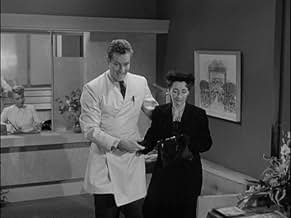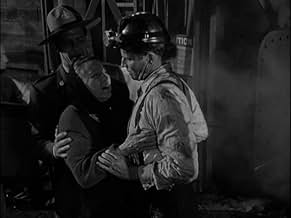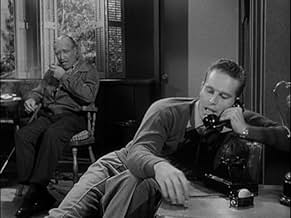CALIFICACIÓN DE IMDb
5.8/10
1.1 k
TU CALIFICACIÓN
Un médico que regresa de la Guerra de Corea a su ciudad natal en Pensilvania debe decidir qué hacer con su vida.Un médico que regresa de la Guerra de Corea a su ciudad natal en Pensilvania debe decidir qué hacer con su vida.Un médico que regresa de la Guerra de Corea a su ciudad natal en Pensilvania debe decidir qué hacer con su vida.
- Dirección
- Guionistas
- Elenco
Philip Ahlm
- Minor Role
- (sin créditos)
Elsie Baker
- Mrs. Olzoneski
- (sin créditos)
Mary Benoit
- Party Guest
- (sin créditos)
Opiniones destacadas
Charlton Heston ("Col. Owen") returns from almost ten years as an army surgeon to his Pennsylvania home to find that his dead brother has been accused of sloppy practices that caused fatalities at a coal mine. His mother (Mildred Dunnock) and local doctor "Scobee" (Rhys Williams) hope he will stay and help the local community, but he discovers that his late brother had run up quite a bit of debt and determines to pay it back. A chance meeting with the "Helen" (Lizabeth Scott) - the daughter of the man who holds the debt - introduces him to new opportunities. She is wealthy, twice divorced, and well connected. His quick thinking after an incident at a party sees an association with prominent, and rather venal, doctor "Gleeson" (Lester Matthews) offer him a route to success and prosperity. Along the way, he proposes to "Helen" and all looks set fair. Much of this film takes a swipe at the hypochondriac patients - mostly wealthy women - and at the physicians who are little better than charlatans; charging a small fortune for glorified Alka Seltzer. Will "Owen" continue to be satisfied with this increasingly unfulfilling existence or will his innate instincts developed during wartime send him back to tend to the more legitimate and urgent needs of the community at large? Heston is a bit on the wooden side here, he delivers his dialogue rather stiltedly and without much passion. Scott is adequate - but more as an effective conduit for the decisions the doctor might make, and there is a decent, if sparing, contribution from Dianne Foster as the voice of reason in the man's increasingly conflicted life - and not just professionally, either. It's way too wordy but it does offer food for thought about practices that probably still exist today and is a bit better than I was expecting.
Charlton Heston and Lizabeth Scott are "Bad for Each Other" in this predictable 1953 film, also starring Mildred Dunnock, Arthur Franz, Marjorie Rambeau, and Dianne Foster.
Heston plays a doctor who returns from the service to the coal town where he grew up. After meeting the wealthy, twice-married, shallow Scott, he decides not to stay in the service and becomes a society doctor, in it for the money. The nurse he hires to work for him (Foster) thinks he's better than that.
The role played by Arthur Franz, that of a young doctor who admires him and doesn't mind going into the trenches, is essentially Heston's conscience.
I found this film pretty bland, but the big problem for me was that the main character as portrayed by Heston was just not likable. He wasn't likable before he took up with Scott nor was he likable throughout the film. Some of this was in the script, but some of it was in his line readings. He had fat attitude every time he opened his mouth. Frankly I didn't care what he did.
Lizabeth Scott was best earlier in her career, in her noir days, where her great voice, sexy blond looks, and ambiguous performances fit very well. Her character in this also was annoying. Now, she's not supposed to be likable, but we should have been able to see why Heston liked her. She seemed awfully pushy for his character to have put up with her.
Heston was tall, handsome, with a great voice and a dominating presence. This film was unfortunately directed in a somewhat old-fashioned manner so as to seem melodramatic and over the top. When someone with that strong a screen persona is directed that way, his performance becomes too actor-y.
Nothing special.
Heston plays a doctor who returns from the service to the coal town where he grew up. After meeting the wealthy, twice-married, shallow Scott, he decides not to stay in the service and becomes a society doctor, in it for the money. The nurse he hires to work for him (Foster) thinks he's better than that.
The role played by Arthur Franz, that of a young doctor who admires him and doesn't mind going into the trenches, is essentially Heston's conscience.
I found this film pretty bland, but the big problem for me was that the main character as portrayed by Heston was just not likable. He wasn't likable before he took up with Scott nor was he likable throughout the film. Some of this was in the script, but some of it was in his line readings. He had fat attitude every time he opened his mouth. Frankly I didn't care what he did.
Lizabeth Scott was best earlier in her career, in her noir days, where her great voice, sexy blond looks, and ambiguous performances fit very well. Her character in this also was annoying. Now, she's not supposed to be likable, but we should have been able to see why Heston liked her. She seemed awfully pushy for his character to have put up with her.
Heston was tall, handsome, with a great voice and a dominating presence. This film was unfortunately directed in a somewhat old-fashioned manner so as to seem melodramatic and over the top. When someone with that strong a screen persona is directed that way, his performance becomes too actor-y.
Nothing special.
Bad for Each Other ([BFEO) is an obscure modestly regarded film that Charlton Heston made as a Paramount contract employee on loan out to Columbia at the dawn of his cinematic acting career. It was preceded by his excellent western movie Arrowhead, and immediately followed by his well regarded unusual adventure film The Naked Jungle (all made in 1953). BFEO (unlike Arrowhead and The Naked Jungle) is a contemporary social melodrama with a story set in a coal mining suburb of Pittsburgh. Heston is a recently discharged MD who is faced with the usual dilemma such folks often have to deal with: should he be a capitalist and seek out the most lucrative opportunity to practice medicine or a humanitarian and apply his skills to help the less fortunate people in his community? This is the issue at the heart of BFEO.
Heston is conflicted and somewhat self-righteous as he comes to grips with his personal values and convictions. Complicating matters are those individuals who are the major influences in his life: a predatory society woman who has set her sights on him (Lizabeth Scott), an idealistic nurse (Dianne Foster), a young doctor who believes that fulfillment can only come from assisting the poor (Arthur Franz), an older doctor who has a small practice in the mining community (Rhys Williams) and a.mother who believes that he should stay and work in his home town (Mildred Dunnock).
BFEO has a plot that contains echoes from other films: So Big (1932), The Citadel (1938), Not as a Stranger (1955), How Green Was My Valley (1941) and The Best Years of Our Lives (1948). It was directed in workmanlike fashion by veteran Irving Rapper, and the acting is consistently interesting. Heston is sincere, stalwart and occasionally naive in his troubled soul-searching, Scott (cast against type) is a spirited if not entirely credible rich young matron, Foster is a beautiful and appealing supporting player, Franz (a successful TV actor at the time) is quite engaging in his idealistic role, Williams is strong and dependable as always and Dunnock makes a most realistic mother trying to help her son with his choices in life. This excellent cast lifts BFEO from being a routine somewhat derivative entertainment, and the film certainly deserves a fresh reconsideration by a modern audience.
Heston is conflicted and somewhat self-righteous as he comes to grips with his personal values and convictions. Complicating matters are those individuals who are the major influences in his life: a predatory society woman who has set her sights on him (Lizabeth Scott), an idealistic nurse (Dianne Foster), a young doctor who believes that fulfillment can only come from assisting the poor (Arthur Franz), an older doctor who has a small practice in the mining community (Rhys Williams) and a.mother who believes that he should stay and work in his home town (Mildred Dunnock).
BFEO has a plot that contains echoes from other films: So Big (1932), The Citadel (1938), Not as a Stranger (1955), How Green Was My Valley (1941) and The Best Years of Our Lives (1948). It was directed in workmanlike fashion by veteran Irving Rapper, and the acting is consistently interesting. Heston is sincere, stalwart and occasionally naive in his troubled soul-searching, Scott (cast against type) is a spirited if not entirely credible rich young matron, Foster is a beautiful and appealing supporting player, Franz (a successful TV actor at the time) is quite engaging in his idealistic role, Williams is strong and dependable as always and Dunnock makes a most realistic mother trying to help her son with his choices in life. This excellent cast lifts BFEO from being a routine somewhat derivative entertainment, and the film certainly deserves a fresh reconsideration by a modern audience.
Maybe if John Garfield had been cast instead of Charlton Heston (who looks and moves like Frankinstein's monster here); and if the producers (writers? director?) had not backed away from the mine safety, health, and company criminal negligence theme that packs a punch in the first ten minutes of the movie.
Army surgeon Charlton Heston is happy with his work, but a visit home to the coal-mining town he was born in,as well as society vamp Lizabeth Scott, make him think there's more to life than patching up wounded soldiers. At first he's interested in serving the poor people he grew up with. However Miss Scott gets him a job with society doctor Lester Matthews and becomes engaged to him. He finds his practice consists largely of giving nostrums to wealthy women at $250 a visit. Finally his nurse, Dianne Foster, leaves him to assist Dr. Arthur Franz, who's taking care of the miners and their families. His crisis of faith, however, is yet to come.
Heston has already developed his deep-throated growl in this movie, although he has not perfected it. It has a quality to it that I think is supposed to denote dissatisfaction, but sounds whiny to me. In a world where everyone else struggles for status and wealth, it's up to the woman at the top of both trees to point out the necessity of honesty and honor; well, she's the only one who can.
Heston has already developed his deep-throated growl in this movie, although he has not perfected it. It has a quality to it that I think is supposed to denote dissatisfaction, but sounds whiny to me. In a world where everyone else struggles for status and wealth, it's up to the woman at the top of both trees to point out the necessity of honesty and honor; well, she's the only one who can.
¿Sabías que…?
- TriviaAccording to December 1950 articles in The Hollywood Reporter and the Los Angeles Times, producer Hal B. Wallis purchased the rights to the novel before it was published for $100,000 ($1.3M in 2024). Wallis intended the leads to be Burt Lancaster and Patricia Neal and that the project was to be filmed at Paramount. It never got off the ground, and Wallis ended up selling the rights to Columbia in early 1953.
- ErroresThe beginning scenes of movie show coal mine operations in Coalville, PA. The railroad caboose was from ATSF (Atchison, Topeka, and Santa Fe). That railroad never had operations in Pennsylvania.
- Citas
Dr. Tom Owen: [on the phone with his wife] Oh, I'm interviewing nurses, of course... Don't be silly, darling - of course she'll be fat and ugly. I do insist on good legs, though.
Selecciones populares
Inicia sesión para calificar y agrega a la lista de videos para obtener recomendaciones personalizadas
- How long is Bad for Each Other?Con tecnología de Alexa
Detalles
- Tiempo de ejecución1 hora 23 minutos
- Color
Contribuir a esta página
Sugiere una edición o agrega el contenido que falta



































